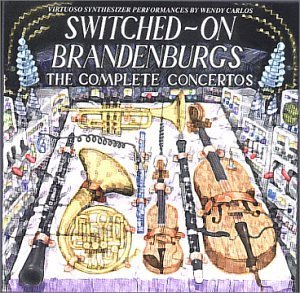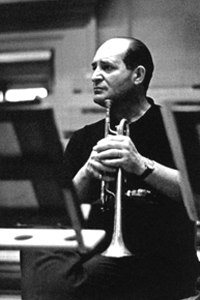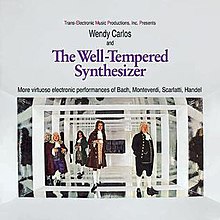Wendy Carlos is an American musician and composer best known for her electronic music and film scores.

Trevor David Pinnock is a British harpsichordist and conductor.

Switched-On Bach is the debut album by American composer Wendy Carlos, originally released in October 1968 by Columbia Records. Produced by Carlos and Rachel Elkind, the album is a collection of pieces by Johann Sebastian Bach performed by Carlos and Benjamin Folkman on a Moog synthesizer. It played a key role in bringing synthesizers to popular music, which had until then been mostly used in experimental music.
Ralph Leonard Kirkpatrick was an American harpsichordist and musicologist, widely known for his chronological catalog of Domenico Scarlatti's keyboard sonatas as well as for his performances and recordings.
The year 1721 in music involved some significant events.
The year 1718 in music involved some significant events.
The year 1704 in music involved some significant events.

Switched-On Brandenburgs is a 1980 double album by Wendy Carlos. It was the seventh album released by Carlos, and the fourth album in her project of classical music which also included Switched-On Bach (1968), The Well-Tempered Synthesizer (1969), Switched-On Bach II (1974), and Switched-On Bach 2000 (1992). It was the first album she released under the name of Wendy Carlos rather than Walter Carlos.

Roger Louis Voisin was an American classical trumpeter. In 1959, The New York Times called him "one of the best-known trumpeters in this country."

Sonic Seasonings is a studio double album by American keyboardist and composer Wendy Carlos, originally released under her birth name Walter Carlos, in 1972 by Columbia Records. The album features four ambient music tracks, each based on one of the four seasons, combining various field recordings with sounds from a Moog synthesizer. It marks a departure from her previous two albums which featured synthesized renditions of pieces of classical music. The album reached No. 168 on the US Billboard 200. In 1998, it was remastered for CD with two previously unreleased tracks.

Baroque music refers to the period or dominant style of Western classical music composed from about 1600 to 1750. The Baroque style followed the Renaissance period, and was followed in turn by the Classical period after a short transition. The Baroque period is divided into three major phases: early, middle, and late. Overlapping in time, they are conventionally dated from 1580 to 1650, from 1630 to 1700, and from 1680 to 1750. Baroque music forms a major portion of the "classical music" canon, and is widely studied, performed, and listened to. The term "baroque" comes from the Portuguese word barroco, meaning "misshapen pearl". The works of George Frideric Handel and Johann Sebastian Bach are considered the pinnacle of the Baroque period. Other key composers of the Baroque era include Claudio Monteverdi, Domenico Scarlatti, Alessandro Scarlatti, Alessandro Stradella, Tomaso Albinoni, Johann Pachelbel, Henry Purcell, Georg Philipp Telemann, Antonio Vivaldi, Jean-Baptiste Lully, Jean-Philippe Rameau, Marc-Antoine Charpentier, Arcangelo Corelli, François Couperin, Johann Hermann Schein, Heinrich Schütz, Samuel Scheidt, Dieterich Buxtehude, and others.

The Handel organ concertos, Op. 4, HWV 289–294, are six organ concertos for chamber organ and orchestra composed by George Frideric Handel in London between 1735 and 1736 and published in 1738 by the printing company of John Walsh. Written as interludes in performances of oratorios in Covent Garden, they were the first works of their kind for this combination of instruments and served as a model for later composers.
Maurice Cole, was an English pianist, teacher and adjudicator. He was born in London and studied at the Guildhall School of Music and privately with Arthur De Greef in London and Brussels.

The Twelve Grand Concertos, Op. 6, HWV 319–330, by George Frideric Handel are concerti grossi for a concertino trio of two violins and cello and a ripieno four-part string orchestra with harpsichord continuo. First published by subscription in London by John Walsh in 1739, they became in a second edition two years later Handel's Opus 6. Taking the older concerto da chiesa and concerto da camera of Arcangelo Corelli as models, rather than the later three-movement Venetian concerto of Antonio Vivaldi favoured by Johann Sebastian Bach, they were written to be played during performances of Handel's oratorios and odes. Despite the conventional model, Handel incorporated in the movements the full range of his compositional styles, including trio sonatas, operatic arias, French overtures, Italian sinfonias, airs, fugues, themes and variations and a variety of dances. The concertos were largely composed of new material: they are amongst the finest examples in the genre of baroque concerto grosso.
The Musette, or rather chaconne, in this Concerto, was always in favour with the composer himself, as well as the public; for I well remember that HANDEL frequently introduced it between the parts of his Oratorios, both before and after publication. Indeed no instrumental composition that I have ever heard during the long favour of this, seemed to me more grateful and pleasing, particularly, in subject.

Anthony Newman is an American classical musician. While mostly known as an organist, Newman is also a harpsichordist, pianist, composer, conductor, writer, and teacher. He is a specialist in music of the Baroque period, particularly the works of Johann Sebastian Bach, and has collaborated with such noted musicians as Kathleen Battle, Julius Baker, Itzhak Perlman, Eugenia Zukerman, Jean-Pierre Rampal, Leonard Bernstein, Michala Petri, and Wynton Marsalis, for whom he arranged and conducted In Gabriel’s Garden, the most popular classical record of 1996.

Switched-On Bach II is a musical album by Wendy Carlos in 1973 on Columbia Records and produced by Carlos and Rachel Elkind and is a sequel to the 1968 album Switched-On Bach.

Switched-On Rock is an album by the Moog Machine, released in 1969 on Columbia Records. It comprises instrumental covers of popular songs from the 1960s, performed on the Moog synthesizer. It was one of a spate of albums capitalizing on the success of Switched-On Bach (1968), an album of Bach pieces performed on the Moog by Wendy Carlos.

Johann Sebastian Bach wrote his fifth Brandenburg Concerto, BWV 1050.2, for harpsichord, flute and violin as soloists, and an orchestral accompaniment consisting of strings and continuo. An early version of the concerto, BWV 1050.1, originated in the late 1710s. On 24 March 1721 Bach dedicated the final form of the concerto to Margrave Christian Ludwig of Brandenburg.












